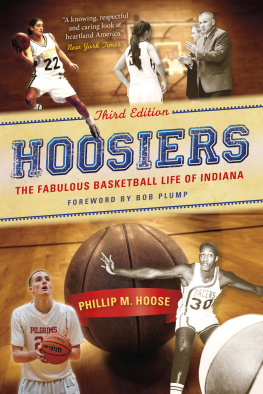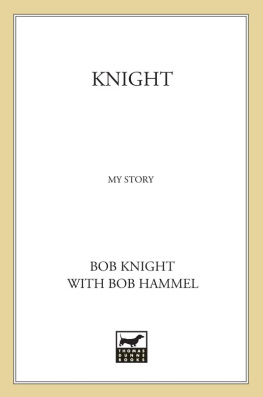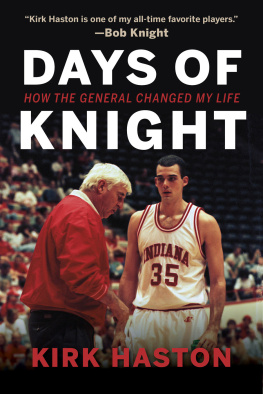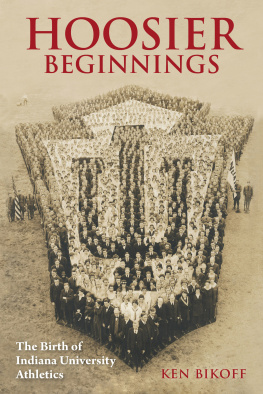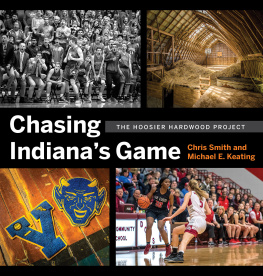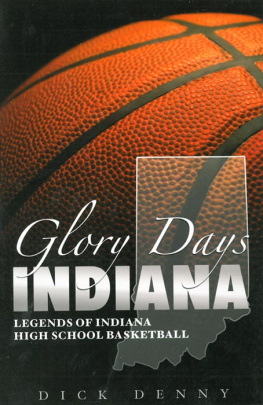
Copyright 2003, 2012 by Stan Sutton and John Laskowski All Photos, unless otherwise noted, courtesy of IU Athletics or IU Archives.
All Rights Reserved. No part of this book may be reproduced in any manner without the express written consent of the publisher, except in the case of brief excerpts in critical reviews or articles. All inquiries should be addressed to Sports Publishing, 307 West 36th Street, 11th Floor, New York, NY 10018.
Sports Publishing books may be purchased in bulk at special discounts for sales promotion, corporate gifts, fund-raising, or educational purposes. Special editions can also be created to specifications. For details, contact the Special Sales Department, Sports Publishing, 307 West 36th Street, 11th Floor, New York, NY 10018 or sportspubbooks@skyhorsepublishing.com.
Sports Publishing is a registered trademark of Skyhorse Publishing, Inc., a Delaware corporation.
Visit our website at www.sportspubbooks.com
10 9876 5432 1
Library of Congress Cataloging-in-Publication Data
Laskowski, John.
Tales from the Indiana Hoosiers locker room : a collection of the greatest
Indiana basketball stories ever told / John Laskowski with Stan Sutton. p. cm.
ISBN 978-1-61321-016-1 (alk. paper)
1. Indiana University, BloomingtonBasketballHistory. 2. Indiana Hoosiers (Basketball team)History. 3. Indiana Hoosiers (Basketball team)Anecdotes. I. Sutton, Stan. II. Title.
GV885.43.I53L37 2011
796.3236309772255-dc23
2011042052
Printed in China
Acknowledgments
The history of Indiana University basketball has been documented for nearly a century by writers who followed the fortunes of the IU team, whether it be referred to as the Crimsons, the Hurryin Hoosiers, or, more lately, just plain Hoosiers. By any name Indiana basketball has received national recognition, not only for its success on the court but because of the vast audience that follows its fortunes.
This book is an attempt to compile special memories of the men who called themselves Hoosiers, whether it was in the days of the underhand free throw or the skyhook. Former players contacted by the authors were gracious in their help, usually showing that while their bodies may age, their memories are largely unfrayed by time. Such is the case with William Silberstein, who played in the 1930s, as well as with such fellow Hoosiers as Bob Leonard, Joby Wright, Gary Long and Jimmy Rayl.
A special thanks goes to the IU Media Relations Office, director Jeff Fanter and basketball director Pete Rhoda for making their archives available. These include student managers logbooks from the 1920s and newspaper clippings from those days through the Mike Davis era. A special thanks to former sports information director Tom Miller for his vast memories of IU basketball and to such storytellers as the original television Voice of the Hoosiers, Paul Lennon.
Contents
Chapter 1
How the Hoosiers Got that Way
Chapter 2
Tales from Lazs Memory Bank
Chapter 3
Great Hoosiers, Good Hoosiers and Memorable Hoosiers
Chapter 4
Common Threads that Bind Hoosiers
Chapter 5
Vintage Hoosiers
Chapter 6
Branch Unveils the Hurryin Hoosiers
Chapter 7
29 Years Under Bob Knight
Chapter 8
The Problems of Succeeding a Legend
Chapter 9
Some Especially Memorable Games
Chapter 10
The Championship Years
Chapter 1
How the Hoosiers Got that Way
Indiana has been a state of many divisions since it joined the union in 1816. U.S. Highway 40, which runs from Richmond on the east boundary to Terre Haute on the West, conveniently splitting Indianapolis through the middle, divides the state into North and South regions. While the split hardly reaches Mason-Dixon proportions, it allows Hoosiers to think of themselves as Northern Indiana residents or Southern ones.
An even bigger separation divides those who live in rural areas from Hoosiers who have settled into more metropolitan lifestyles. Except for those in The Regiona complex of Chicago suburbs including Hammond, East Chicago, Whiting, Gary and Portagemost Hoosiers think of themselves as rural. Even longtime Indianapolis residents, who recall when their hometown was unkindly called Naptown, have deep ties with agricultural Indiana.
Regardless of their home sites, Indiana residents pretty much see themselves as equal. Former Indiana football player Jay Davis, a native of Rushville, perhaps best described the feelings of many of these Hoosiers.
I consider myself a city boy, but theres a farm right down the street, he said.
Since 1911, the year the Indiana high school basketball tournament was launched, basketball exceeded all other interests in Hoosierland. Barbershops were the sites of discussions about corn crops, the price of eggs and the pastors sermon from the previous Sunday But mostly they provided the setting for discussions, and arguments, about basketball.
Surely, bragging rights started in Indiana.
The Indiana high school tournament consisted of one class until 1998, and another dividing point existed: People either lived in cities where their favorite team had a chance to win a state championship, or they lived in a town where it was impossible. But even before tiny Milan won the 1954 title, every fan believed his or her team had a chance, although those in places such as Muncie and Kokomo knew it was realistic.
Interest in Indiana University basketball was an offspring of this lifestyle. The four weeks of the high school tournament were televised before IU games were shown on the tube. The NCAA Tournament was founded in 1939, three years after the Frankfort Hot Dogs established themselves as probably the best high school team in Indiana history.
By then another dividing line had formed between in-state residents, who had to decide whether they favored the Indiana Hoosiers or the Purdue Boilermakers. Feelings over this issue would grow until nearly no one was neutral about the rivalry. The West Lafayette University always had a strong fan base in northwestern Indiana and among the farming communities, a result of Purdues agricultural and engineering schools.
IU fans were spread more evenly around the state, partly because the university produced doctors, lawyers, businessmen and teachers who would establish homes in various settings.
Bragging rights reached a new level.
Some houses were divided. One Bloomington couple endured a Saturday in March when their respective colleges, Indiana and Purdue, played each other on the same day their high schools, Franklin and Speedway, met in the state high school finals.
During the early days of the rivalry, the Boilermakers were so dominant that it now would take some 15 years without losing for the Hoosiers to assume the series lead.
Purdue launched its basketball program in 1896, while Indiana didnt fall in line until the turn of the century, when Purdue won nine straight games over the Hoosiers. By 1914, the Boilermakers had a 22-3 lead in the rivalry.
Indiana since has cut into the disadvantage and, in the estimation of the IU fans, overwhelmed any embarrassment by capturing five NCAA championships. Despite 21 Big Ten championships (Indiana has 20), the Boilermakers only ventures into the Final Four were in 1969 and 80.
Indiana won its first national title in 1940 and followed with a second under coach Branch McCracken in 1953- By that time the then Hurryin Hoosiers had slipped ahead of Purdue in the consciousness of many in-state fans, but by the early 70s Purdue again was laying claim to being


